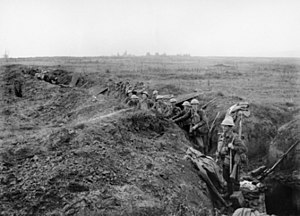Battle of Epehy
| Battle of Épehy | |||||||
|---|---|---|---|---|---|---|---|
| Part of the Hundred Days Offensive of World War I | |||||||
 The Western Front, 1918 |
|||||||
|
|||||||
| Belligerents | |||||||
|
|
|
||||||
| Commanders and leaders | |||||||
|
|
|
||||||
| Strength | |||||||
| 12 divisions 1,500 artillery pieces |
At least 6 divisions | ||||||
| Casualties and losses | |||||||
| Total: unknown |
Total: unknown Captured: 11,750 men and 100 artillery pieces |
||||||
The Battle of Épehy was a battle of the First World War fought on 18 September 1918, involving the British Fourth Army (under the command of General Henry Rawlinson) against German outpost positions in front of the Hindenburg Line.The village of Épehy was captured on 18 September by the 12th (Eastern) Division.
Field Marshal Sir Douglas Haig, Commander-in-Chief (C-in-C) of the British Expeditionary Force (BEF) on the Western Front, was not eager to carry out any offensives, until the assault on the Hindenburg Line, influenced by mounting British losses from previous battles that year, over 600,000 casualties since March, 180,000 of them in the past six weeks. Rawlinson was kept reined in and advised by Haig to ensure his men were well rested for the eventual attack on the Line. When news arrived of the British Third Army's victory at the Battle of Havrincourt, Haig's mind was changed. On the day following the success at Havrincourt, 13 September, Haig approved Rawlinson's plan to clear German outpost positions on the high ground before the Hindenburg Line and preparations began.
...
Wikipedia
